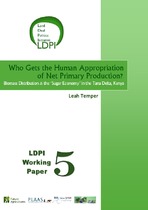Who gets the human appropriation of net primary production?: Biomass distribution & the ‘sugar economy’ in the Tana Delta, Kenya
Abstract
In this article we focus on the connection between purchases of land and the emerging ‘biomass-economy’, analysing
biomass distribution in a region targeted for land-grabbing in order to understand the process from both bio-physical
and political ecological perspectives. We narrow the focus down to a case study in the Tana Delta, Kenya, one of the
new commodity frontiers in the recent large-scale land acquisitions, employing an indicator derived from social
metabolism analysis — the Human Appropriation of Net Primary Production (HANPP). This allows us to examine
biomass flows in the Delta, combining a biophysical perspective with a political-ecology analysis of the interests,
stakes and power politics in the delta. The first section introduces the conceptual tools and theoretical framework,
expanding on the concept of the ‘sugar economy’ as a socio-metabolic transition, and material and energy flow
analysis (MEFA) as valuable instruments in gauging sustainability and potential sites of conflict over biomass. The
second section contextualises the case study of the Tana Delta in Kenya as a site of conflict over biological resources
through an analysis of property rights and historical dynamics. The third section presents the results of the analysis of
biomass distribution. The fourth and fifth sections offer discussion of the results and the conclusions.

